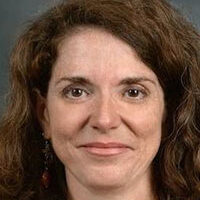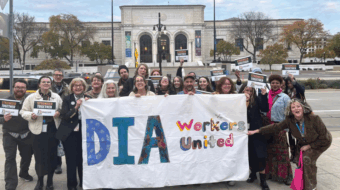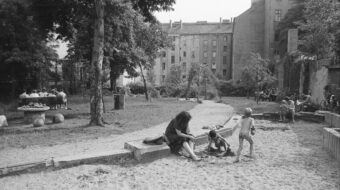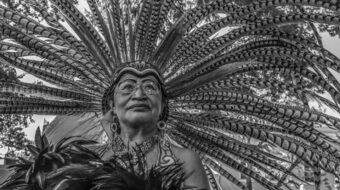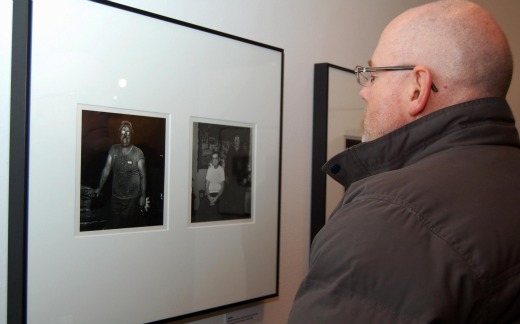
CHICAGO – The gallery was packed, students scribbling on their notepads or taking snapshots with their iPhones, gray-haired and gray-bearded viewers in their winter finery trying to make their way from photo to photo. Hundreds milled around enjoying hot dogs with sauerkraut and jalapeños, kettle chips in a paper cone, New York City’s iconic black and white cookie, and of course, Western New York’s Genesee beer.
And so went the opening of “The Working-Class Eye of Milton Rogovin” at Roosevelt University’s Gage Gallery here, Jan. 20. Buffalo, N.Y.-based Rogovin, 101, had died just two days before the long-planned exhibition, turning the celebration of his art into a celebration of his life.
Exhibit curator and gallery director Michael Ensdorf said the opening is a “celebration of Milton’s rich and long life. He said tributes from all over the world came pouring in for Rogovin, on Twitter, Facebook, New York Times, NPR and the Library of Congress blog.
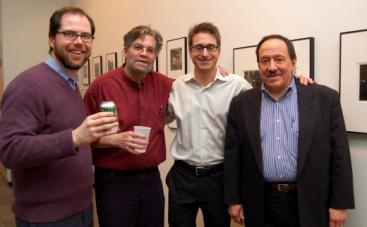 Ensdorf worked with Roosevelt labor historians Erik Gellman and Jack Metzgar and combed through1,000 images housed currently at Mark Rogovin’s, Milton’s son, Forest Park home.
Ensdorf worked with Roosevelt labor historians Erik Gellman and Jack Metzgar and combed through1,000 images housed currently at Mark Rogovin’s, Milton’s son, Forest Park home.
Ensdorf introduced Mark by saying his biography keeps Milton’s “spirit of arts and activism” alive today. Rogovin, an artist and activist whose accomplishments include founding The Peace Museum, was visibly moved by the outpouring of support, while mourning the death of his father.
Mark paid tribute to his mother, Ann, who died in 2003, as a true partner in his father’s art. “Mom was integral in everything my dad did, except work in the dark room.”
As he presented a few family slides, Rogovin shared a particularly ironic and funny story, about waiting for his father’s hospice caregivers at his Buffalo home. “We were waiting for the caregiver to arrive and heard the doorbell. As we opened the door, the woman standing there said, “Hi. I am Jo McCarthy.”
Milton and Ann Rogovin, like thousands of others at the time, were attacked for their political beliefs during the dismal days of Joe McCarthy’s communist witch-hunts. Milton’s optometry business was ruined by the relentless redbaiting, FBI hounding and attacks in the media. He was called to testify before the House Un-American Activities Committee and refused to name names or answer the un-constitutional question, “Are you a member of the Communist Party?”
The headline in The Buffalo Evening News the next day read: “Rogovin Named as Top Red in Buffalo, Balks at Nearly All Queries,” which was just one of five redbaiting articles in the newspaper that day.
In Milton’s obituary, that same newspaper reports without remorse “the repercussions on the Rogovins and their three children, Paula, Ellen and Mark, were devastating.”
Yet, somehow, out of the devastation, the Rogovins turned to the working class people of Buffalo and Western New York – Black, Italian, Puerto Rican, Native and Arab Americans – for solace and inspiration, and found a unique artistic voice in photographing the lives of the unsung.
“The rich have their own photographers. I photograph the forgotten ones,” Milton Rogovin liked to say. And so launched an incredible journey that is just now gaining the recognition it deserves.
The Rogovins’ journey took them beyond the East and West Sides of Buffalo and Lackawanna steel factories and foundries to Appalachia, Chile, Zimbabwe, Spain, Mexico and Cuba, where in black and white Milton captured the global commonalities of working people and the human spirit.
Mark Rogovin said his father was not a trained photographer and did not study other social realist photographers like Walker Evans, but was influenced by the art of Kathe Kollwitz, Vincent Van Gogh, Honore Daumier and Francisco Goya, all of whom had “love and respect for the poor.”
However, Mark said, his father did receive technical help from his friend and photographer, Minor White.
The Gage exhibit includes Rogovin’s first social documentary series, “Storefront Churches – Buffalo,” completed in 1960. After receiving less than stellar feedback from some African American friends, Milton Rogovin wrote to the towering intellectual and activist, W.E.B. Du Bois, “to ask if I could show him my photographs and get his opinion about my ‘Storefront Church’ series” because the criticisms “troubled” him.
Du Bois invited Rogovin to his Brooklyn home and “expressed great interest” in the series and offered to write an introduction to them. The introduction and series appeared in the photography magazine, Aperture. In the introduction, Du Bois frames the series by quoting from his own 1903 book, “The Souls of Black Folk”:
“The music of Negro religion is that plaintive rhythmic melody, with its touching minor cadences, which, despite caricature and defilement, still remains the most original and beautiful expression of human life and longing yet born on American soil.”
Du Bois’ introduction appears with the series Gage exhibition, as does Rogovin’s favorite poem, “A Worker Reads History” by Bertolt Brecht.
Other series at the Gage include Appalachia and portraits from the untitled Working People series, 1976-81. In the Working People series, you see foundry workers, miners and mold makers at work and at home. It helps uncover the multi-dimensional answers to “why a worker works” and who a worker earns money for.
One Black foundry worker poses in front of and with his hand on an industrial-size bucket, perhaps used to carry and pour the molten steel, and at home, looking older with his revealed thinning and graying hair, covered up in the work photo by his head protector. But the same hand is now holding his grandchild on his lap next to a table of Christmas cards with a portrait of Jesus on the wall above.
Rogovin said he let his subjects decide on the poses, but in one work/home portrait of a white mold maker, you would think the photographer positioned his subject for the symmetry of the two shots. Sitting sideways on what looks like a huge mold, the worker is framed by his tools, an air gun, goggles, earphones, and dust mask. At home, he sits sideways on a table surrounded by Elvis posters and album covers and a picture of the Last Supper.
Another worker at Shenango Ingot Mold was interviewed about his job as a chipper. He says, “A chipper tries to make them perfect, cut the bumps off them. It’s my job to make it right … A good chipper knows more about what should be done than the boss.”
Rogovin interviewed many steelworkers, and son Mark said they have 16.5 hours of digitized interviews available for researchers, history teachers and others. The Rogovin family has built a user-friendly website with folios and teacher’s guides to help a new generation learn about issues of race, working-class people, social photography and the 1960s-1980s.
History it is, as most of these jobs have disappeared, and a “chipper” must sound as ancient as a” muleskinner” to some. Which begs a critical question, where are the contemporary work/home portraits? And who are the next generation of artists to digitally capture them?
Where is the next Milton Rogovin?
For more People’s World stories on Milton Rogovin, click here.
Photos: A viewer looks at a set of photos at the Jan. 20 opening. Second photo, from left to right, Erik Gellman, Mark Rovogin, Mike Ensdorf and Jack Metzgar at the Gage Gallery. (Giacomo Luca/The Torch)


